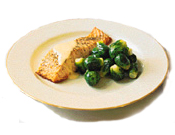|
|
Cuisine Glossary
| You have reached our International Cuisines and information on all aspects of a countries cuisine.
We will try to explain the culture, significant influences, climate, and other factors that have come together to create a distinct style. For example: Spanish, Mexican or Japanese. |
Austrian Cuisine
 |
Austrian cuisine in general: It is the culinary reflection of an ethnically mixed people who, during the many centuries of the Austrian Habsburg empire's expansion and contraction, have exchanged culinary know-how with Turkish, Swiss, Alsacian, French, Spanish, Dutch, Italian, German, Bohemian-Moravian, Hungarian, Polish, Croatian, Slovenian, Slovakian, Serbian, and Jewish cuisine. Typical Austrian dishes vary today according to the Bundeslander culinary history and to each Bundesland's agriculture with its export/import tradition.
For example, Burgenland cuisine is influenced by its flat topography and proximity to Hungary. Its specialties are prepared with abundant locally grown fruits and free roaming chicken and geese, and include dishes like the Buergenlandisches Erdbeerkoch (a type of baked strawberry mush dessert) and Buergenlandische Gaenseleber (goose liver simmered with onions). East southern Kaernten/Carinthia and Steiermark/Styria's cuisines, with Hungarian, Yugoslavian, and Italian culinary influences, feature Mediterranean style foods, including ham, a favorite ingredient in all three surrounding countries, and mild climate herbs and vegetables. Dishes from these areas include Steirisches Verhackert's (diced Speck (Austrian cured ham) mixed with minced garlic and heavy flavored pumpkin seed oil) or Steirisches Poulard (roasted herb stuffed capon or chicken). Niederoesterreich/Lower Austria's way of cooking reflects historic ties with eastern, Middle Eastern, and oriental cooking, and includes Serviettenknoedel mit Semmelkren (baked bread loaf with saffron gravy) and Gezogener Apfelstrudel (an almost transparent roll of pastry dough filled with apples which has common culinary roots with oriental baklava). Source: by Elisabeth Castleman |




